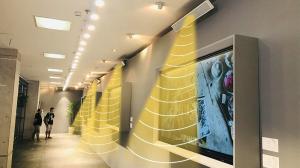Farewell to Noise Pollution: Directional Sound Technology Shows Promise in Public Spaces
Audfly Technology, a company known for its innovations in acoustic engineering, has been piloting directional sound solutions in various public venues across Europe and North America. Unlike conventional speakers, which disperse sound broadly and inevitably spill into surrounding areas, Audfly’s directional sound technology product focus audio precisely where it is needed. The result: clear, intelligible messages or audio content without disturbing the wider environment.
In a recent case study at the Modern Art Gallery, visitors reported a markedly improved experience. “We were able to guide audio narratives to specific exhibition areas without the chatter overlapping or spilling into other rooms,” said Dr. Lars Weber, Chief Curator. “It creates a sense of intimacy and reduces auditory fatigue, which is essential in spaces designed for reflection.”
Schools and outdoor recreational areas are also seeing potential benefits. At a pilot project in Beijing, directional speakers installed on playgrounds and sports fields allowed announcements and music to be clearly heard by students while significantly reducing noise disturbance for neighboring residential areas. Environmental psychologist Prof. Elena Martinez notes, “The ability to localize sound precisely not only protects the acoustic environment but also contributes positively to mental well-being, by limiting exposure to intrusive noise.”
Urban planners and smart city designers are taking notice. As public spaces increasingly incorporate multimedia experiences, directional sound can be a tool for enhancing both social interaction and environmental responsibility. By minimizing the audio footprint, cities can maintain quieter, more pleasant streetscapes while delivering targeted messages for safety, guidance, or entertainment.
Audfly has developed a range of directional sound solutions suitable for both indoor and outdoor environments, addressing the unique acoustic challenges of each setting. In addition, its Alpha Series directional sound modules are particularly well-suited for integration into kiosks, digital signage, and other interactive terminals, delivering precise audio exactly where it is needed. According to Marcus Holden, an acoustic engineer and consultant for city planning, “Technologies like this give us the flexibility to design soundscapes intentionally. We can control what people hear in specific areas without adding to general noise pollution—a challenge that traditional public address systems often struggle to overcome.”
Directional sound technology is gaining wider recognition and is playing an increasingly important role across a variety of public and private settings, with Audfly’s directional sound solutions demonstrating practical benefits in both indoor and outdoor environments. For cities looking to embrace smart, human-centered planning, controlling the auditory environment is emerging as a key frontier.
Wei Ke
Audfly Technology
email us here
Visit us on social media:
LinkedIn
Legal Disclaimer:
EIN Presswire provides this news content "as is" without warranty of any kind. We do not accept any responsibility or liability for the accuracy, content, images, videos, licenses, completeness, legality, or reliability of the information contained in this article. If you have any complaints or copyright issues related to this article, kindly contact the author above.


